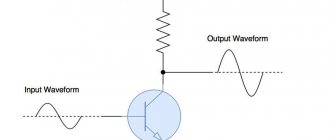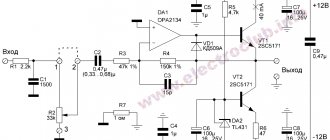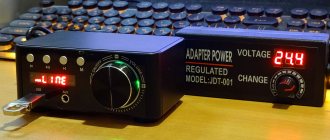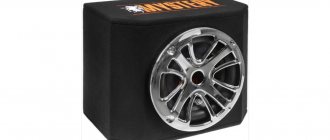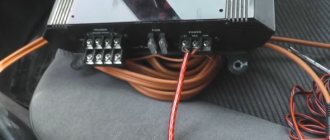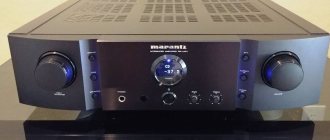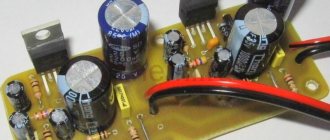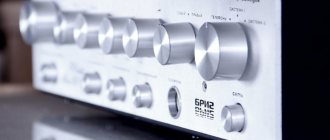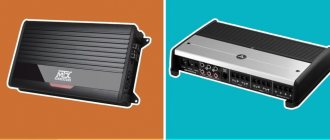With all the variety of circuit solutions used in sound amplifiers, one can easily trace continuity and gradual, evolutionary development between them. First there was class A, then B, then AB and all those following it, which are essentially a further development of class AB or A with all the advantages and disadvantages attached to it. But it’s so good that among Hi-Fi manufacturers there are real innovators who are not afraid to introduce bold technological solutions! Otherwise, you and I would never have known about the existence of Class D amplifiers.
Story
In the world of Hi-Fi, class D has the hardest fate, and its development did not occur due to objective advantages, but rather contrary to prevailing opinion. It all started with the fact that class D was literally immediately given the offensive, in the opinion of some audiophiles, label “digital amplifier”. And although some of the principles of its operation do resemble the operation of digital circuits, at its core it is a completely analog device.
Another misconception that accompanies class D is age. It is believed that Class D was developed quite recently and is a by-product of modern digital technology. In fact, Class D has a rich history, and its first implementations were designed back in the era of radio tubes. Our compatriot Dmitry Ageev proposed using this type of circuitry to amplify sound (class D in tube design), and this happened in 1951. Around the same time, the English scientist Alex Reeves was working on the practical implementation of such a device, and in 1955, their colleague Roger Charbonnier from France, creating a similar scheme, first used the term “class D”.
At the very beginning, when mainly theoretical research was carried out, the fate of class D seemed cloudless. Its calculated characteristics literally reached the limit of perfection. However, the first commercial implementation in 1964 revealed a lot of weaknesses, the main one being the inability to achieve truly decent sound quality using the element base of that time.
Manufacturers did not give up hope, and in the seventies, attempts to bring Class D amplifiers to the market were made by such giants of the Hi-Fi industry as Infinity and Sony. Both ventures failed for the same reason as the first time. Transistors suitable for performance and accuracy class began to be mass-produced only in the eighties, after which high-quality implementation of class D amplifiers became a reality. Nowadays, class D amplifiers can be found in completely different devices: from smartphones and household equipment to studio equipment and High-End systems.
Principle of operation
The principle of operation of class D amplifiers and any of its modifications, including those with independent letter designations (classes T, J, Z, TD and others), is based on the principle of Pulse Width Modulation or, in short, PWM. Signal modulation as a method has existed for quite a long time and is used as a method of storing and transmitting information. Its essence is to modulate a certain carrier frequency with a useful signal. The frequency is selected in such a way that it is convenient to transmit or record on a medium. The playback process involves the reverse sequence: separating the useful signal from the modulated carrier frequency. Digital technology, radio communications, and television and radio broadcasting work on this principle. The subtlety is that in the case of PWM, a completely different goal is pursued. Modulation allows you to bring the signal into such a form that its amplification is as simple and effective as possible.
Class D circuitry is based on a generator of microwave pulses (counting in hundreds of MHz) of a carrier frequency and a comparator - a device that modulates these pulses according to the shape of the incoming analog signal. Everything else is simple. The modulated signal has the form of pulses of equal amplitude but different durations, which are amplified using a pair of symmetrically connected high-speed MOSFET transistors. Next, the circuit uses a simple LC filter that demodulates the amplified signal, as well as cutting off the carrier frequency and accompanying high-frequency noise.
The mention of transistors used for amplification raises a reasonable question: “wouldn’t it be easier to immediately amplify the analog signal without any modulation?” And it is this question that reveals the essence of class D amplifiers. In conventional amplifiers of classes A, B, G and their other derivatives, the transistor operates with a broadband signal that is constantly changing in both amplitude and frequency. The behavior of even the best transistor at different amplitudes and frequencies is not 100% the same, which inevitably leads to distortion, which we know as the coloration or “character” of the amplifier. The modulated signal in class D amplifiers changes discretely and at full amplitude. Thus, the operating mode of transistors is significantly simplified and becomes much more predictable. Essentially, they act as a key, being either in a closed or open state with no intermediate values.
All that is required from the transistor in this mode is to respond as quickly as possible to changes in the signal level, and its behavior at intermediate amplitude values does not matter. In addition, this operating mode of the transistor has an extremely positive effect on the energy efficiency of the amplifier, bringing its theoretical efficiency to 100%.
The second most obvious question concerns the similarity between modulated analog and digital signals. Usually this is not even a question, but a statement: “The Class D amplifier is digital, which means it is correct to supply a digital signal to its input, not an analog one.” The process of modulating an analog signal at the input of a class D amplifier is indeed very similar to what happens in an ADC when digitizing audio, but the modulation principle is fundamentally different from that used in the PCM format.
It is for this reason that the digital inputs of integrated amplifiers operating in class D use a completely traditional DAC circuit, from the analog output of which the signal is fed to the input of the power amplifier board. Thus, the analog signal is the primary and natural input signal for Class D amplifiers.
However, there are exceptions, which, if you look at it in more detail, do not change anything in the overall picture, but only complement the standard class D circuitry. The well-known Peter Lyngdorf, while still a developer at NAD, successfully implemented a scheme for directly converting a PCM stream directly into the format PWM without traditional digital-to-analog conversion procedure. This technology is called Direct Digital, or in Russian: direct digital signal amplification.
In this way, it was possible to reduce the length and reduce the complexity of the audio path, and the only digital-to-analog conversion in such a circuit is carried out directly in front of the acoustic terminals. However, it is worth noting that for such an amplifier to operate with an analog signal, it must also have a classic input stage, used in traditional class D amplifiers.
At the moment, the technology of direct digital amplification has not yet become a mass phenomenon, probably because Mr. Lyngdorf has competently filed patent rights for the technology or simply prefers not to reveal all the secrets to his colleagues. But not so long ago, a similar scheme was successfully implemented in portable equipment, which allows us to hope for a wider distribution of the technology in the future. It is possible that after some time the class D will indeed become a digital amplifier.
How do class AB amplifiers work?
Obviously, a good amplifier should operate without distortion. In other words, the output signal must exactly repeat the input signal in its shape. But, unfortunately, nothing is perfect, including electronic components.
For example, transistors have the property that they open and close not entirely proportionally to the input signal. In other words, their work is nonlinear. It's like if you turn the handle of a faucet, the water will flow weakly at first, and then at some point the pressure will suddenly increase sharply.
Due to this nonlinearity, transistors in AB-class amplifiers usually have to be kept slightly open even when there is no signal. This is necessary so that when even the slightest signal appears, they start working immediately, and do not wait until the signal reaches a certain level. This way the amplifier will operate with minimal distortion, and this would seem to solve the problem.
In reality, this means that some of the useful energy will be wasted by the amplifier. Just imagine that you open all the taps in your house, and a trickle of water constantly flows through each of them.
But transistors are never completely open either. If this happens, it means that the output signal has reached its maximum, and then the amplifier will simply begin to limit it (clipping).
As a result, it turns out that there will always be losses of useful energy in AB-class amplifiers, and the efficiency is far from ideal 100%. In practice, their effectiveness usually ranges from 40% to 70%. Low efficiency is the main disadvantage of AB-class amplifiers.
pros
The main advantage of class D amplifiers, for the sake of which the story with signal modulation was started, is energy efficiency. Moreover, both in theoretical calculations and in real figures, this gives such an increase in efficiency, which can only somehow be compared with the transition from class A to classes B and AB, and all the achievements of class G and others against its background seem like a rather weak attempt .
When operating in pulse mode, the transistor spends half the time in a completely closed state, which means it has zero quiescent current and consumes no energy. At the same time, at the moment of switching on, the transistor operates at full power, redirecting all the energy coming from the power supply to the output of the amplifier.
As a result, these same theoretical 100% efficiency, when implemented in practice, give truly excellent values of the order of 90–95%. And since only a few percent of the energy is spent on heating the transistors, radiators can be used in vanishingly small sizes. To obtain an output of 100–200 W per channel, a class AB amplifier must have radiators occupying one or both side walls of the case, and a class D amplifier will make do with a piece of aluminum the size of one or two matchboxes.
By the way, the same can be said about the size of the power amplifier board: in class D it turns out to be many times more compact, even if it is assembled not on microcircuits, but on discrete elements. Well, to top it all off, class D amplifiers have a lower cost than models of other classes of comparable power. However, the latter applies more to DIY projects - manufacturers prefer to invest the saved money in improving sound quality and other improvements, especially since in class D there really is something to improve.
Which amplifier is better - D-class or AB-class?
For a long time, it was believed that you should choose AB-class amplifiers for connecting speaker systems, because they do not require high power and have less distortion. This was due to the fact that in D-class amplifiers the input signal was usually converted into a pulse signal at a low frequency, and as a result they worked well only in the subwoofer range.
Today, technology has stepped far forward; powerful, high-speed transistors have appeared that can switch (open and close) almost instantly. Quite a few broadband D-class amplifiers have appeared on the market. Wideband are D-class amplifiers that are designed for use not only with subwoofers, but also with speaker systems. For those cases where high power is not needed, such amplifiers can be made extremely compact.
Minuses
Having absolutely killer advantages, class D has not conquered the Hi-Fi market entirely only because it has its weaknesses, which for many connoisseurs of high-quality sound look much more significant than energy efficiency. The presence of a high-frequency generator in the circuit is itself a potential source of electromagnetic interference, which negatively affects the sound of the amplifier itself and the operation of the audio path components adjacent to it.
An untrained listener may not notice this effect or not attach any importance to it, but in the Hi-Fi and High End industry, when every little thing matters, such proximity is not welcome and forces engineers to improve filter circuits and go to other tricks to eliminate the influence malicious microwave carrier frequency generator to the reproduced audio signal.
The high efficiency of class D amplifiers is the reason for one specific feature: the high dependence of the quality and sound character on the power supply. If the manufacturer decides to use a switching power supply and does not bother with a sufficient number of filtering circuits, some of the noise will definitely penetrate the speakers and spoil the sound impression. A bad power supply, of course, will not benefit class AB, but it is in class D that this problem manifests itself most acutely.
Peculiarities
Descriptions of the pros and cons of class D circuitry give absolutely unambiguous hints about what developers who strive to achieve maximum quality sound from amplifiers should primarily do.
Developers solve the problem of powering class D amplifiers in two ways. Some follow the proven path, using classic linear power supplies with huge toroidal transformers and other classic solutions. But there is another path that a minority of developers take. With the right skill, it is quite possible to create a low-noise switching power supply suitable for installation in amplifiers of the highest quality class. And it is they that are able to give a head start to the most powerful and reputable linear power supplies due to better efficiency and performance, and as a result, better sound dynamics and instant response of the amplifier to large differences in signal levels.
As for the specifics of the operation of the class D amplifier itself, its circuit design provides a significantly higher damping coefficient in comparison with class AB and other circuit solutions. This guarantees not only stable operation with complex loads, fast, clear bass and a large dynamic range, but also ensures lower levels of distortion, the absence of muss, sluggish attack or blurred fronts and, most importantly, the ability of the amplifier to equally cope with completely diverse music.
How do amplifiers work?
First you need to understand how any amplifier works. You might be surprised, but in fact it... does not enhance anything. The principle of its operation is more similar to the operation of a regular water tap - you turn the handle, and the water flows either stronger, or weaker, or not at all.
In amplifiers, everything happens exactly the same way - current from a powerful power supply is passed through a speaker connected to the amplifier. The role of the “faucet” is performed by the output transistors, and their opening and closing is controlled by the signal that goes to the amplifier from the head unit. And it is how this “faucet” (output transistors) works that determines the class of the amplifier.
Practice
The honorable duty of defending the honor of class D amplifiers in our study fell to the Marantz PM-KI RUBY amplifier. This device has an exemplary layout that demonstrates how modern amplifiers should be created. Two Hypex NCore 500 modules operating in class D are powered by a special low-noise switching power supply. At the same time, the design of the amplifier contains a classic preliminary stage, built on discrete elements, according to Marantz’s proprietary HDAM technology, which was also used in traditional class AB amplifiers.
The preliminary stage is powered by a linear power supply, the toroidal transformer of which, judging by its size, has a multiple power reserve so as not to in any way affect the dynamics and purity of sound. In other words, two approaches are combined in one housing: a classic one for a preamplifier and a modern one for a power amplifier.
All this is richly seasoned with the typical attention to detail for High-End models, such as a copper-plated chassis, improved vibration isolation, shorter signal paths, symmetrical board topology, strict selection of parts according to parameters, etc.
As a result, we have perhaps the most advanced device from a technical point of view with a damping factor of 500, distortion of less than 0.005% and power consumption of 130 W with an output power of up to 200 W per channel at 4 Ohm load. However, any claim to perfection in the world of sound must be verified by practice.
↑ Reflections and conclusions
We live in a world of stereotypes.
Some consider the 4A32 the crown of creation, not suspecting that in good modern 30 cm speakers the moving system can weigh less than 30 grams. Someone sleeps with a 6P3S lamp under their pillow. Someone heats their house with class A, removing 10 W of useful power at the output. Particularly stubborn people polish the wires, forgetting about the thousands of semiconductors on the way from the CD player's laser to the DAC output. My comrades also told me that I had betrayed the idea... But I never asserted anything without listening and trying, on the basis of someone else’s authoritative opinion. What's your head for? I usually check and listen. So this is my opinion about class D - super! Technology that we once sorely lacked.
One day, an old friend of mine, with whom I went to school, came into my office. Common interests in technology, but different paths in life. And I have a converted 1983 S-70. All that was left of the speakers were the woofers and filters. I simply threw the rest away, which I don’t regret at all. I just couldn't get the speakers yet. The tweeters are new - isodynamic, the old ones were pierced by children. The enclosures are custom-made, ~140 liters, bass reflex, each assembled weighs about 50 kg. I test amplifiers on them. Well, of course I listen in the background.
“Do you remember,” he said, “we used these speakers to pump up the gym at school!” “I remember,” I answered, “but do you know what we really lacked then?” - What? - Class D! — Yes, I wish I could rewind 30 years, remove someone’s home “Amphiton 101” + fan and put a device the size of a book on the table. - And tear everyone apart!
At this stage of development of sound reproduction equipment, the weak link is not the amplifier or the source. These devices have long surpassed the capabilities of human hearing in their characteristics. The most problematic thing is the speaker. Especially, as we like - broadband - cheap and cheerful. Manufacturers' promise, frequency response measurement - how it turns out depends on the case and overall implementation. In reality, the sound is influenced by so many factors that getting an equivalent speaker THD below 1% in the midbass is already a serious problem.
The middle and top - they have almost decided - with the same electrostats or a serious reduction in the mass of the moving system with a simultaneous increase in strength.
The size of the room and standing waves are a quest; car enthusiasts love to solve it every day, increasing the power of the amplifiers, the size and weight of the speakers, because there is no other way to fool physics.
And what a delight the resonances on diffusers are - anyone who has encountered them will not let you lie.
Therefore, I want to express my opinion - these amplifiers are in no way inferior to a good class AV amplifier, with the exception of better low-end response and smaller dimensions of the case itself. And in terms of efficiency, they tear everyone apart.
And this is a “laboratory”, I did not expect much from these devices. If performed well, the parameters will be even better if you set this as a goal.
That's all I have for now. Thank you for your attention!
PS
Recently I noticed that manufacturers of audio equipment began to proudly write
“Class D”
.
But “SMPS”
was never written. Strange, right?
Sound
The amplifier produces a very free, beautiful sound with excellent detail, rich timbres and long natural after-sounds of live instruments. The scene is built as accurately and as large as possible, with reliable representation of the proportions and location of virtual sound sources in space. Everything is quite consistent with the idea of how a good High End amplifier should play. There is no synthetics, harshness or “discreteness” that some adherents of the old school find in the sound of class D. On the contrary, the Marantz PM-KI RUBY successfully combines the best objective characteristics with the signature sophisticated and effortless presentation of musical material.
This typically “Marantz” sound manifests itself, first of all, in excessive intelligence when playing metal and hard rock. At the same time, classics of any composition, jazz and vocals sound very lively and natural. A very similar, perhaps even slightly more beautiful and sugary sound character was exhibited by Marantz amplifiers of previous years operating in class AB, which allows us to conclude that the sound of class D power amplifiers is neutral.
Connecting acoustics of different power, with different sensitivity and different impedance to the Marantz PM-KI RUBY amplifier gave the quite expected result: the absence of any pronounced reaction to changes in these parameters. The amplifier handled any stereo pair equally confidently.
Even under the most difficult load and at high volume, the lower notes of the double bass were surprisingly consistently reproduced - they sounded absolutely clearly, without hum, with a natural transmission of the sensation of a vibrating string and the soundboard of the instrument responding to this vibration. In a word, everything happened exactly as it should happen with an amplifier that has the declared combination of power and damping factor.
Top 12 Best Audio Amplifiers 2022
The best transistor audio amplifiers
NAD C 338
NAD C 338 Photo: NAD
An interesting model that has several advantages. Firstly, the user will be pleased with the appearance and workmanship. This sound amplifier is very compact, but has great functionality - it can serve as a network player and an amplifier at the same time. Add speakers and a phone as a sound source, and you are guaranteed good musical accompaniment. There are two inputs, the connection can be made using a cable, Bluetooth or Wi-Fi. The price is very reasonable compared to many powerful models.
Main characteristics
| Number of channels | 2 |
| Front channel power | 50 W (4/8 Ohm, 20 Hz - 20 kHz) |
| Reproducible frequency range | 20 - 65000 Hz |
| Signal to noise ratio | 104 dB |
| There is a MM phono stage | |
| There is a DAC | 192 kHz/24 bit |
Advantages and disadvantages
This device has good build quality. The compactness of the amplifier will not cause problems with where to put it
No USB input for connecting a computer
show more
Best AV Receivers
AV receivers are the best they have come up with for sound reproduction
Musical Fidelity M6si black
Musical Fidelity M6si black Photo: Musical Fidelity
A solid integrated amplifier in which you will immediately notice its classic, strict design. Buyers will also be pleased with the high power output. The device provides an extended dynamic range, as well as a three-block layout with separate power amplifiers. With such an amplifier, each voice and musical instrument comes from its own point in virtual space and it sounds very cool.
Main characteristics
| Number of channels | 2 |
| Front channel power | 220 W (8 Ohm) |
| Reproducible frequency range | 10 - 20000 Hz (+0, -0.1 dB) |
| Signal to noise ratio | 107 dB |
| There is a phono stage MM, MC | |
| There is a DAC | 96 kHz/24 bit |
| Power consumption | 680 W |
Advantages and disadvantages
A very powerful sound amplifier, music lovers will also be pleased with the excellent tonal balance
There is no headphone output and no optical or coaxial input
show more
Denon PMA-60
Denon PMA-60 Photo: Denon
This sound amplifier has a compact size and modern design. It can be placed both horizontally and vertically. The display image rotates depending on the position of the device. Premium materials are used in the decoration - glass display, metal panels, side panels are made of good plastic. You can connect to a DAC—a digital-to-analog converter—via USB, coaxial cable, or optical. There is also a subwoofer output. The set includes a modern remote control.
Main characteristics
| Number of channels | 2 |
| Front channel power | 50 W (4 ohms, 1 kHz, harmonic distortion 0.7%), 25 W (8 ohms, 20 Hz - 20 kHz, harmonic distortion 0.07%) |
| Signal to noise ratio | 110 dB |
| There is a balance adjustment | |
| There is a tone control | |
| DAC | 384 kHz/32 bit |
Advantages and disadvantages
The compact size allows you to place the device the way you like, the model has a beautiful design, supports NFC
This amplifier is not powerful enough to drive huge music centers.
show more
The best tube audio amplifiers
TAC 34
TAC 34 Photo: TAC
This tube model is praised for its pleasant, natural sound: it is suitable for listening to classical music, jazz, old rock music and more. The appearance of the amplifier is reminiscent of retrospective devices that have survived to this day in exactly this version. According to the manufacturer, the amplifier produces powerful dynamic sound without losing quality. First-class components make up the element base of the device, while the presented appearance confidently proves its consistency.
Main characteristics
| Number of channels | 2 |
| Front channel power | 50 W (4.8 ohms, 0 dB) |
| Reproducible frequency range | 20 - 60000 Hz (+/- 1.5 dB) |
| Signal to noise ratio | 90 dB |
| Input impedance | 100 kOhm |
Advantages and disadvantages
Excellent clear sound, interesting design
This model needs to warm up for about 20 minutes for it to sound at full power.
show more
Luxman SQ-N150 Silver
Luxman SQ-N150 Silver Photo: Luxman
The tube amplifier is part of the NeoClassica model range, the equipment of which is made in the classic design of this company. The device is made on the basis of the famous SQ-5A model, which at one time became one of the first high-quality stereo amplifiers. The device has a beautiful retro design, which is given additional chic by the signal level indicators on the front panel. The tubes in the amplifier are covered with a removable mechanical casing. The output stages of the model are equipped with Russian-made EL84 lamps. Combined with a high-quality wideband transformer, they provide an output power of 10 W per channel into a 6 ohm load impedance. These lamps are characterized by fast and transparent sound, which is great for listening to music of any genre. Here you will also find branded tone controls that will allow you to fine-tune the sound character of various musical compositions.
Main characteristics
| Number of channels | 2 |
| Lamps | 2x ECC83, 4x EL84 |
| Front channel power | 10 W (6 ohms) |
| Reproducible frequency range | 20 - 80000 Hz (-3 dB) |
| Signal to noise ratio | 95 dB |
| Input impedance | 47 kOhm |
Advantages and disadvantages
In addition to its beautiful design, the model has important functions. So, there is a phono stage, balance control and tone control.
Not the most powerful device in the line of tube sound amplifiers
show more
Acoustics for home
Uncover the nuances of all musical compositions
Trafomatic Audio Experience One
Trafomatic Audio Experience One Photo: Trafomatic
The creators of this model claim that the product is the result of many years of development in the field of transformers for lamp technology. Here buyers will find a unique design of the device itself and good sound. The design of the amplifier contains wood and metal, which transports users to the retro times that lovers of tube models so reverence. The output power is 4W, so the manufacturer recommends the use of acoustics with increased sensitivity (95 dB and higher). Buyers also note the excellent detail of the amplifier's sound - it is very clear and creates an immersive effect, as if the listener is in the hall in which musicians are performing this or that composition.
Main characteristics
| Number of channels | 2 |
| Electronic components used | lamps: 2x 2A3-40 JJ, 2x ECC 81, 1x 5U4G |
| Front channel power | 4 W |
| Reproducible frequency range | 10 - 36000 Hz |
| Signal to noise ratio | 75 dB |
| Input impedance | 100 kOhm |
Advantages and disadvantages
Excellent sound detail. A design that takes you back to retro times
There is no support for wireless connections via Airplay, and there are no USB Type A connectors
Best Hi-Fi Audio Amplifiers
Sim Audio MOON 600i
Sim Audio MOON 600i Photo: Sim Audio
This solid stereo amplifier with a red display is capable of providing loud and clear sound when playing any music file within the perimeter of small and medium-sized apartments. The body of the device is black with silver inserts around the edges. On the upper plane of the device there are slits that perform a decorative function and also serve as ventilation grilles. The dimensions of the model allow you to easily install it on a shelf or on a table, installing a pair of speakers at the edges. A convenient remote control is included. The amplifier can be controlled even as part of a smart home - by voice or through a gadget. The sound is clear and crystalline, this is especially noticeable after the first warm-up of the device.
Main characteristics
| Number of channels | 2 |
| Front channel power | 125 W (8 ohms), 250 W (4 ohms) |
| Reproducible frequency range | 110 - 100000 Hz (+0/-0.1 dB) |
| Signal to noise ratio | 120 dB |
| Has a display | |
| Sensitivity | 490 mV |
Advantages and disadvantages
Excellent sound, high-quality performance, convenient sizes for installing the amplifier on a shelf or table
It is recommended not to disconnect this device from power. After each new switch-on, it takes 20-30 minutes to reach normal power mode
Hi-Fi acoustics
High-quality sound costs money, but the investment is justified by sound without flaws
TEAC AX-505 black
TEAC AX-505 black Photo: TEAC
The amplifier consists of Hi-Fi components made in a compact form factor. The model uses specially tuned Hypex NCore D-class amplifier modules with a high reputation in the audio environment. As the manufacturer notes, the power supply contains an overload-resistant toroidal transformer, as well as a rectifier equipped with fast Schottky diodes, which increases operating efficiency, reduces noise and improves sound dynamics. The amplifier has protection against overheating, overcurrent, exceeding the permissible voltage value and produces a power of 115 W per channel at a four-ohm load or 70 W at 8 ohms. Users highlight the sound separately - neutral with absolute control of the speakers.
Main characteristics
| Number of channels | 2 |
| Front channel power | 115 W (4 ohms, 1 kHz, harmonic distortion 0.8%), 70 W (8 ohms, 1 kHz, harmonic distortion 0.8%) |
| Reproducible frequency range | 10 - 50000 Hz (-5 dB, 8 ohms, 1 kHz, 1 W) |
| Signal to noise ratio | 110 dB |
Advantages and disadvantages
Lightweight miniature model that weighs less than 5 kg. Bright and clear sound. There's also bass control here.
This model does not have a digital-to-analog converter
show more
Parasound A31 Black
Parasound A31 Black Photo: Parasound
The Parasound A31 black sound amplifier will provide realistic and powerful sound to music of any genre. At least that's what the creators of this model say. The device can reveal its capabilities to the maximum when playing classics. The device is capable of correctly playing popular formats, providing an immersive listening experience. Installed permanently on a table or stands, it can serve medium and large rooms. Distinctive features are the modern circuitry used and the ability to adjust the power of the input signal. The toroidal transformer is housed in a metal braid, which increases its power and reduces noise and distortion. Parasound A31 is also equipped with gold-plated screw terminals for speaker systems - this nuance increases the purity of the transmitted sound and minimizes any distortion.
Main characteristics
| Number of channels | 3 |
| Front channel power | 400 W (4 Ohms, 20 Hz - 20 kHz), 250 W (8 Ohms, 20 Hz - 20 kHz) |
| Reproducible frequency range | 5 - 100000 Hz (+0/-3 dB) |
| Signal to noise ratio | 112 dB |
Advantages and disadvantages
The model has high-quality sound, with good detail, which is highly appreciated by users. The device is made of high quality components and will last a long time
Such an amplifier is difficult to move from place to place - it weighs almost 30 kg
show more
Best Budget Audio Amplifiers
Jamo MPA-201
Jamo MPA-201 Photo: Jamo
The MPA-201 model has an output power of 100x2 W into a 4-ohm load (in bridge mode - 200x1 W/4 ohms). The device has a linear input/output for connecting several power amplifiers in series into a common circuit. Despite the far from the highest price on the market, this device performs well and will delight music lovers. Users appreciate its high power, “live” timbres of voices and musical instruments. In addition, the amplifier has a compact size, good assembly, and automatically turns on when a signal is applied. This model can be used both in stereo and as an amplifier for a subwoofer with an adjustable cutoff frequency.
Main characteristics
| Number of channels | 2 |
| Front channel power | 200 W (8 ohms, bridged), 100 W (4 ohms) |
| Reproducible frequency range | 20 - 20000 Hz (-3 dB) |
| Signal to noise ratio | 100 dB |
| Can be used as an amplifier for a subwoofer | 50 Hz, 100 Hz, 150 Hz |
Advantages and disadvantages
Volume can be adjusted directly on the amplifier. There is a useful function of automatic switching on when a signal is given
There are not many indicators on the front panel; the model is slightly inferior in appearance to its competitors in this regard
show more
Integrated amplifier SMSL SA-98E black
SMSL SA-98E black Photo: SMSL
One of the most affordable amplifiers on the market. Small, simple and powerful - this is how customers describe it, and this is a true description. The device's sounds are not distorted, everything is clearly audible. The price of this model compared to competitors on the market is simply ridiculous. The mechanism does not heat up, which usually happens with its more powerful analogues. If you need a simple amplifier, without a tone block, without an input selector and without a remote control, then this is your option. It will make any acoustics sound.
Main characteristics
| Number of channels | 2 |
| Electronic components used | chip: ST Microelectronics TDA7498E |
| Front channel power | 160 W (4 ohms), 80 W (6 ohms), 65 W (8 ohms) |
| Sensitivity | 400 mV |
Advantages and disadvantages
Lightweight and miniature device. Does the job adequately and does not distort the sound
The sound detail of this model is not the most ideal.
show more
Home theaters
Excellent quality and easy to install
Cambridge Audio AXA25 Gray
Cambridge Audio AXA25 Gray Photo: Cambridge Audio
The amplifier is made in the signature Cambridge Audio style and has a power of 25 W. The model is equipped with RCA inputs, 3.5 mm jacks, REC outputs and USB for connecting a Bluetooth receiver. The device is suitable for playing CDs. The receiver is capable of operating in two stereo zones. In addition to speakers and a player, you can also connect a turntable and a subwoofer to this model. According to users, this device is ideal for the office. Despite the very low price for sound amplifiers, the model has very clean acoustics.
Main characteristics
| Number of channels | 2 |
| Front channel power | 25 W (8 ohms) |
| Reproducible frequency range | 10 - 30000 Hz (-3 dB) |
| Input impedance | 32 kOhm |
Advantages and disadvantages
Good and high quality sound. Interacts with various equipment
Not the most powerful amplifier on the market
show more
